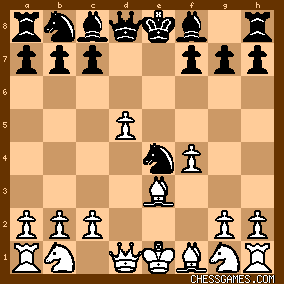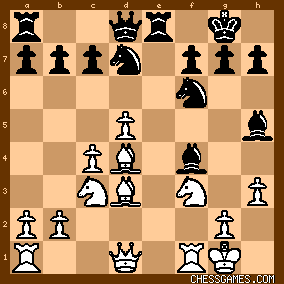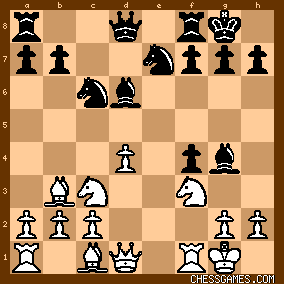|
< Earlier Kibitzing · PAGE 21 OF 21 ·
Later Kibitzing> |
Dec-12-11
 | | Eric Schiller: I'd call this "the passed pawn game". Each side had monster passed pawns. |
|
| Dec-12-11 | | TheFocus: <Eric Schiller> Nice to see you back posting. I hope your health is much better. |
|
| Dec-12-11 | | Shams: <Everett> I've hashed my way through a little 3.Bc4 theory on my own, and there's an Andrew Martin video from about 20 years ago that's pretty good. But there's only one book on the line at all-- I should have it by the end of the month. I may take one fewer class next quarter just to study it. http://www.amazon.com/Fascinating-K... |
|
| Dec-13-11 | | artemis: Shams: 1. e4 e5 2. f4 d5!
This play by black is the primary reason amongst many others that I do not like the King's gambit. Black has the luxury of easy development and can turn it into a gambit of his own after 3. exd5 e4 or he can play 3. ... exf4. This is my favorite response to King's gambit, although I rarely get the chance to play it since I usually play the Sicilian Najdorf/Schevenningan. |
|
| Dec-13-11 | | King Death: <artemis> Don't forget 3...c6 4.Nc3 ef4, which was starting to become popular too when I ended my playing days in the late 80s. |
|
| Dec-14-11 | | Shams: <King Death>, <artemis> Thanks for your thoughts. You two are strong players and I won't be telling you anything you don't already know, but in case some weaker players are following this thread I thought I would write down my responses to your ideas. Of course I'd love it if you responded too. <2...d5> and <3...e4> is not my favorite move-pair to see, it's true. I think theory still likes White in the main-line Falkbeer but I've had a rocky road of it. Have recently been playing <3.ed e4 4.d3 Nf6 5.dxe4 Nxe4 6.Be3> (think Spassky picked this up at one point): 
click for larger viewNow <6...Qh4+> leads to a risk-free position where White can argue for many moves that he is just slightly better. Or so I believe at the moment. <6...Bd6> leads to quick development on both sides and also happens to be, I think, relatively uncharted. White played a very nice game here: Short vs Karjakin, 2008
I like the setup here for white, shipping the f-pawn and playing 4-3 on the queenside with that huge d5 pawn and tons of space to shuffle your minors behind. Check out the position after 12 moves: 
click for larger viewKarjakin has solved the problem of his LSB and is ready to defang the b1-h7 diagonal, but Short is able to ruin his pawns and he wrapped things up impressively...Karjakin had clinched the match the previous game, so may have been coasting a bit. But to me this is looks pretty tidy. ~~~
Now, as for positions where Black takes <...exf4>, a delayed acceptance of the pawn (Eric Schiller and I argued a couple years ago about whether 2...d5 and 3...exf4 counted as the Falkbeer or KGA), it's true these positions must already be equal for Black, but I don't think they're so bad. My rule with Nimzo's <...c6> (mentioned by <King Death> is to always ignore it, which I think is the standard approach-- am I wrong? Eventually Black takes on d5 and we end up in the same place. A third way to get there is 3.Bc4 d5 4.exd5 fxe4. However we get there it often resembles this: 
click for larger view
[Typical ...exf4 position after 10 moves. From J Gallagher vs E Almada, 1991 ] Ok, probably these positions are more than equal for Black. If, you know, one wants to be technical. ("2...exf4 and where is White's compensation for the pawn?" Morozevich has said-- coming from Moro this hurts, Moro who so brilliantly defeated Anand with the King's Bishop Gambit as a spindly teenager, jumping on to the world stage in the process... Morozevich vs Anand, 1995.) Bottom line, for me, I think these ...exf4 positions are interesting: opposing 4-2 pawn majorities are inherently unbalanced and there is lots of scope for creativity. They are definitely dangerous positions, though. Against a well-prepared Black player you could die quickly. But Bronstein said "The King's Gambit is no more of a risk for White than the King's Indian is for Black" and while it's not for me to say, until somebody tells me different I'm going to assume that's still the case today. After all, the King's Indian isn't going anywhere, and Kasparov's statement that "you can't play it unless you're prepared to sacrifice a pawn" isn't news to any KID player. So, sack a pawn as white! And you don't have to learn any Spanish theory. I've burned my bridges with Senor Ruy, if 2.f4 doesn't work out than 1.e4 is out the window too. Sorry for the too-long post. |
|
| Dec-14-11 | | King Death: <Shams> Here are a couple of games in your variation 1.e4 e5 2.f4 d5 3.ed e4 4.d3 Nf6 5.de Ne4 6.Be3. The first game doesn't seem bad, maybe a little better for White, but he should avoid the path taken by Tal in the second game. As far as I know, it's the only time Tal played White in a King's Gambit in a serious game. Spassky vs A Matanovic, 1964 and Tal vs P Trifunovic, 1963. |
|
Dec-14-11
 | | harrylime: McShane played a limp opening and was bust long before the denouement. He writhed, he wriggled, but this game was only going into one mouth.. |
|
| Dec-14-11 | | haydn20: After 30...Re6 why not just snatch 31. Qxa5? |
|
| Dec-14-11 | | bondll: Everyone:
What will McShane's Fide rating be assuming he does not play anymore before the next ratings are posted? Bondll |
|
| Dec-14-11 | | Everyone: <Bondll> How the hell should I know? Am I a walking encyclopedia? |
|
| Dec-14-11 | | bondll: Everyone:
I didn't realize someone's username was "Everyone"! I meant to ask the general readership. Bondll |
|
| Dec-14-11 | | General Readership: Dammit, bondll! I'm trying to keep the front from collapsing and you call me back here for this horse-pucky? I am gonna shove the UCMJ so far up that cactus! |
|
| Dec-14-11 | | SamAtoms1980: <General Readership> We're watching you. You clown around on the wrong page and we'll have to demote you . . . . . to Private. |
|
| Dec-14-11 | | Shams: Not sure if a general can be busted all the way to non-com. <Sam>, what happened to your electron cloud?? |
|
| Dec-14-11 | | SamAtoms1980: Hehe, those weren't electrons ---- they were <muons>, and they came with a half-life of 1⅓ months. |
|
| Dec-14-11 | | Shams: But were they Joshu's muons? |
|
| Dec-15-11 | | SamAtoms1980: <Shams: But were they Joshu's muons?> MU. |
|
| Dec-15-11 | | Shams: Joshu's Muons
The Tau of Pooh
Graviton's Rainbow
Baryon my Wayward Son |
|
| Dec-30-11 | | Ulhumbrus: 10...Bxf3? is a serious positional error which gives up the bishop pair and with it Black's main compensation for having the worse pawn structure. 13 h4?! spends a tempo for development and weakens White's pawn structure on the King side and so makes it more difficult to arrange the advance f4. After 13 0-0 with best play Black may be lost in the long run. <WiseWizard: <Ulhumbrus> There have been thousands of games where people have given up the bishop pair and won.> I count this game as one of the thousands of games where people have given up the bishop pair and could have lost. |
|
| Dec-30-11 | | King Death: < Ulhumbrus: 10...Bxf3? is a serious positional error which gives up the bishop pair and with it Black's main compensation for having the worse pawn structure...> Very often in these Lopez middlegames Black will exchange this bishop because the knight can be more of a long term danger once it swings to f5 and cramps his position. <...13 h4?! spends a tempo for development and weakens White's pawn structure on the King side and so makes it more difficult to arrange the advance f4. After 13 0-0 with best play Black may be lost in the long run.> It'll take some doing for White to play f4 without weakening his own king and Black can castle long anyway.
To say that "...Black may be lost in the long run" is straight out of those Reinfeld books that were around when I was a kid 50 years ago. |
|
| Dec-31-11 | | Ulhumbrus: <King Death: < Ulhumbrus: 10...Bxf3? is a serious positional error which gives up the bishop pair and with it Black's main compensation for having the worse pawn structure...>
Very often in these Lopez middlegames Black will exchange this bishop because the knight can be more of a long term danger once it swings to f5 and cramps his position.> The price for removing the potential source of danger is too high, as Black has no compensation for his doubled pawn apart from his bishop pair. This exchange works only when White is unable to make count his superior pawn structure <<...13 h4?! spends a tempo for development and weakens White's pawn structure on the King side and so makes it more difficult to arrange the advance f4. After 13 0-0 with best play Black may be lost in the long run.>It'll take some doing for White to play f4 without weakening his own king and Black can castle long anyway. To say that "...Black may be lost in the long run" is straight out of those Reinfeld books that were around when I was a kid 50 years ago.> Heidenfeld described Reinfeld as a devotee of Tarrasch. Reinfeld appears to have had some reason to be that. Reinfeld says in his introduction to his book of Tarrasch's best games that Tarrasch played so many fine games that it was a laborious task to select some for a compilation, amd that Tarrasch put his love of chess into some of those games. According to Nimzovich, Tarrasch's rules were at best the tips of an experienced housewife. If we assume that Nimzovich was right to at least some degree, this suggests that Tarrasch and his disciple Reinfeld could be sometimes wrong but also sometimes right. In the present case my Reinfeldesque remark may be right |
|
| Dec-31-11 | | King Death: < Ulhumbrus:...The price for removing the potential source of danger is too high, as Black has no compensation for his doubled pawn apart from his bishop pair. This exchange works only when White is unable to make count his superior pawn structure...> This isn't accurate, because there's more to this position than White's pawns. He had to pay a price for what he gained. Black has a strong grip in the center and this makes it hard for White to open up the game. White's bishop doesn't really have much to do at b2 either. If you noticed in the game itself, Ivanchuk soon swapped off the other bishop. Maybe he understands a little bit more about concrete play than Reinfeld (or even Tarrasch) did. Chess can't be reduced to a set of dogmas where you take two and call the doctor in the morning. |
|
| Jan-01-12 | | Ulhumbrus: <King Death: < Ulhumbrus:...The price for removing the potential source of danger is too high, as Black has no compensation for his doubled pawn apart from his bishop pair. This exchange works only when White is unable to make count his superior pawn structure...>
This isn't accurate, because there's more to this position than White's pawns.> The lion's share of what is more consists of Black's bishop pair. After Black has given this compensation up I maintain that there isn't more in the position than White's pawns that is enough for Black to compensate for White's superior pawn structure> <He had to pay a price for what he gained.> The main price waa the bishop pair which Black relinquished <Black has a strong grip in the center and this makes it hard for White to open up the game.> That is not White's aim. The aim is to play f4 and to keep the centre closed otherwise.> <White's bishop doesn't really have much to do at b2 either.> Not immediately but potentially <If you noticed in the game itself, Ivanchuk soon swapped off the other bishop.> I noticed that Kramnik swapped off the other bishop. That was a concession which he would have liked not to have to make. <Maybe he understands a little bit more about concrete play than Reinfeld (or even Tarrasch) did.> That seems all too believable < Chess can't be reduced to a set of dogmas where you take two and call the doctor in the morning.> Indeed it cannot. |
|
| May-23-24 | | Saniyat24: Luke cannot overlook the pawn on a2...! |
|
 |
 |
|
< Earlier Kibitzing · PAGE 21 OF 21 ·
Later Kibitzing> |





